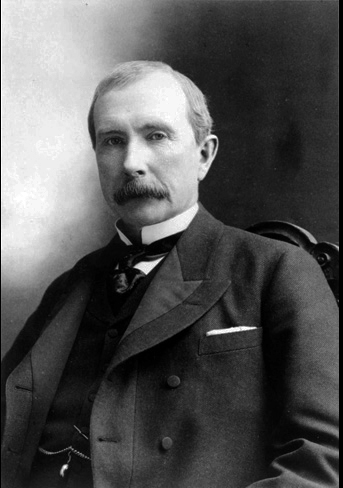John D. Rockefeller: Judson Memorial’s Chief Benefactor
John D. Rockefeller was a determined man who ascended from very humble beginnings to unrivaled wealth and productivity after the Civil War.

What we think of as the modern American economy was, in essence, the creation of four men: Andrew Carnegie, Jay Gould, J.P. Morgan, and John D. Rockefeller. All four were giants of the Gilded Age and lived at a moment of enormous growth that established the United States as the richest, most inventive, and most productive country on the planet. They are considered, quite literally, to be the founding fathers of our modern economy. But with the enormous wealth they amassed, only Carnegie and Rockefeller would also be remembered for their philanthropy.

Rockefeller was the primary benefactor of Judson Memorial Church at the corner of Thompson and Washington Square South who made its construction possible.
John D. Rockefeller was born on July 8th, 1839 in Richford, New York, an upstate town near Binghamton. His father was a traveling “doctor,” and his mother a deeply religious woman who raised John to save money and give to charities.
As a student, Rockefeller was exceptionally good at math, particularly excelling in mental arithmetic: he could solve complicated arithmetic problems in his head with alacrity.
Rockefeller’s secondary education was obtained at Folsom’s Commercial College in Cleveland Ohio, where his family moved in 1853. There he studied bookkeeping, penmanship, commercial history, mercantile customs, banking, and exchange. In 1855 he found a job as an assistant bookkeeper in a firm called Hewitt & Tuttle. He impressed his employers with his diligence, honesty, persistence, and patient, pleasant nature. While he was certainly not making large sums of money, he always gave all he could to his church and to local charity. By both his reputation as a businessman and as a consistent donor to charitable causes, he soon became very much respected in the broader Cleveland community.

Rockefeller’s meteoric rise as a businessman (Standard Oil Trust) was so fast and so successful that it took a great toll on his health. Between 1891-92, all evidence points to a nervous breakdown. He lost all of his hair, including his eyebrows, and suffered from general ill health during those years. In 1891, Rockefeller hired Frederick T. Gates as a full-time manager of his fortune. Gates was charged both with managing his investments as well as managing his huge charitable donations. Rockefeller then retired in 1897 at the age 0f 58. From then on, all his activities were philanthropic.
In 1884, Rockefeller moved his family from Cleveland to New York City. A devout Baptist, Rockefeller was impressed by the works of Edward Judson. Judson was the son of a Baptist missionary to Burma, Rev. Adoniram Judson. The elder Judson had spent 40 years as a missionary abroad. He died at sea in 1850 and was given a burial at sea. His son Edward, an acolyte of his father, took it upon himself to build a New York memorial to him. He envisioned building a memorial that would be a complex—church, children’s home, young men’s building and tower. Rockefeller was the largest donor to the cause, giving $40,000. With this support secured, by October 2, 1889, the plans were underway. The job was given to the most prominent architectural firm in New York at the time; McKim, Mead & White. The firm found inspiration in Rome’s towers of San Georgio in Velabro, and of San Lorenzo in Lucina.

Today, Judson Memorial Church serves as a beacon of light for the faithful as well as for a thriving artistic community and philanthropic endeavors.

